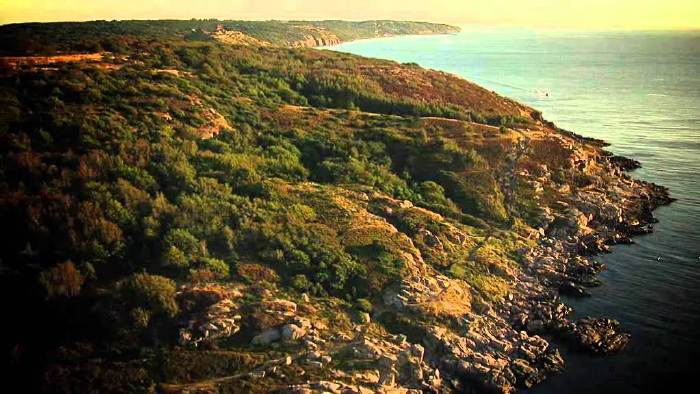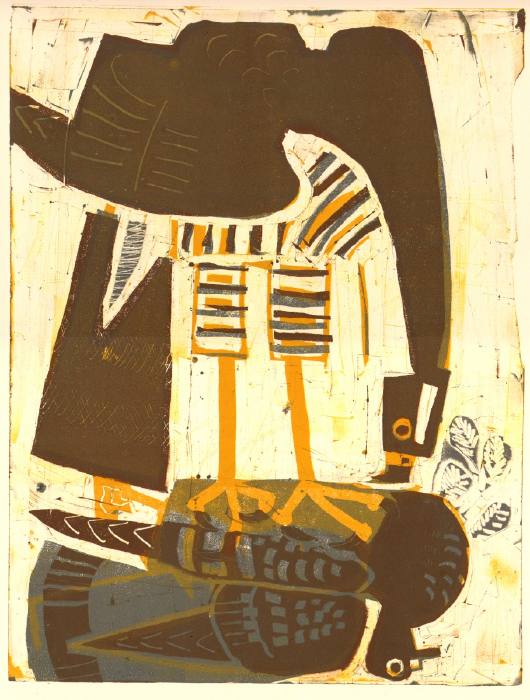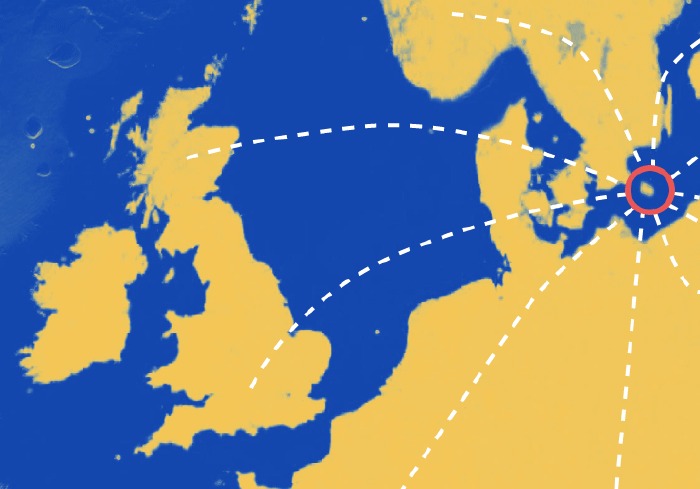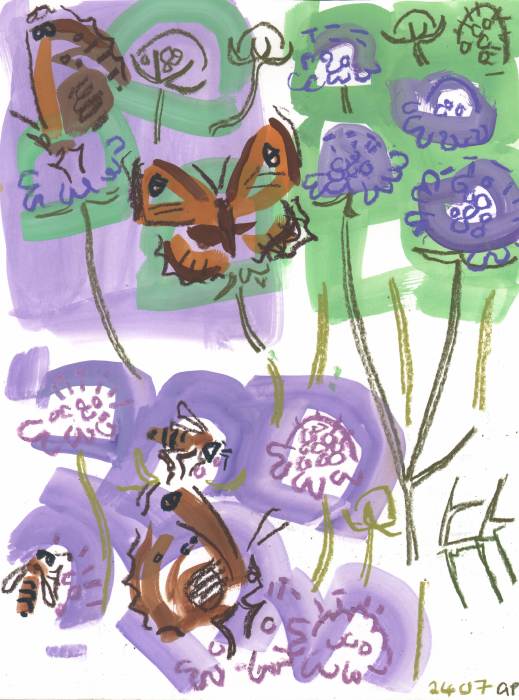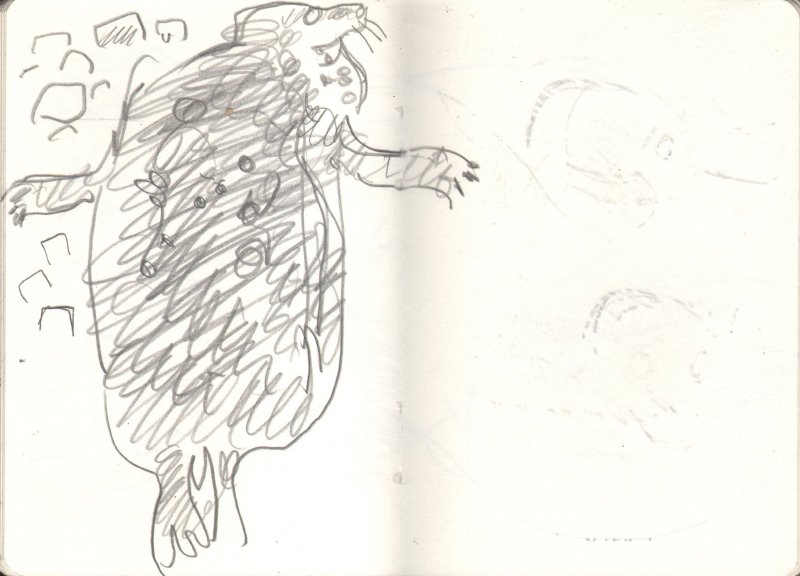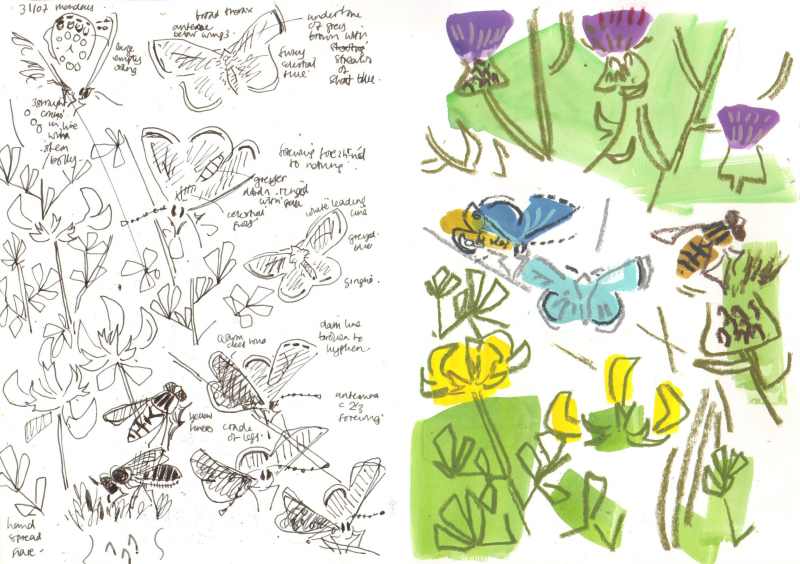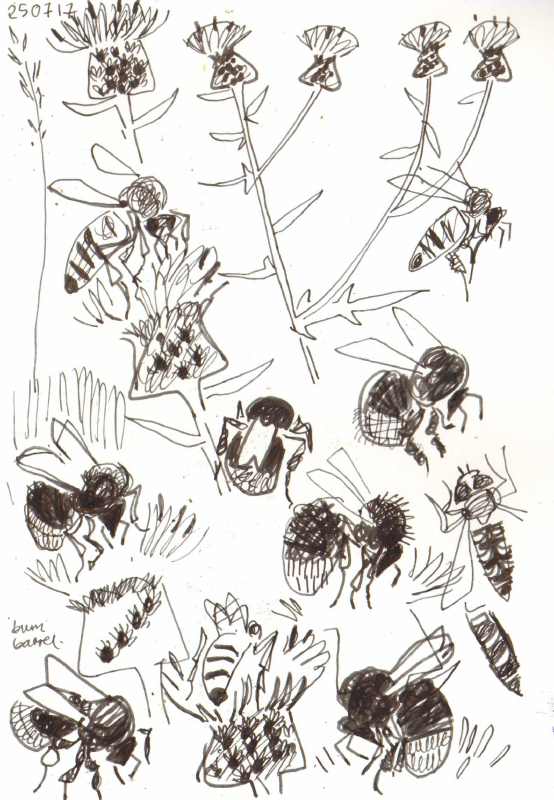(picture: Ben Woodhams)Drawing and painting outside can be both exhilarating and daunting.
This course will use drawing as a way of ‘active looking’. Staying with our subject and getting to know it more intimately. Testing our understanding and exploring different means of interpreting what we see and feel. As long as this process is part of an honest investigation of what we are experiencing there can be no such thing as a ‘bad drawing’. It is all part of a never ending process of trying to understand our world better.
The physical challenges of being outside in all weathers can generate a vibrancy and creativity in our mark-making and creative output that can sometimes be lost indoors. Sustained observation and full immersion in the natural environment is the theme underlying this course. In all weathers and for extended periods of time, course participants will embrace Bornholm’s fantastic natural environment, as we attempt to sketch, draw, and paint under the open skies.
For some the work made outside might normally be a way of collecting raw material that will later be developed indoors. For others the work on the ground may be taken to a finished piece there and then. We will look at how both a quick sketch or a more laboured piece can have their virtues. Both are part of an ongoing process leading towards greater understanding. Working with others exploring similar themes in divers ways gives an inspiring sense of ‘safety in numbers’ as well as a great group dynamism.
Led by Bornholm resident and artist Ben Woodhams and the experienced and highly regarded English printmaker Greg Poole, the course leaders will take you on a journey through the Danish island of Bornholm’s diverse and wide ranging landscape. Visiting some of the lesser-known sites on the island, we will attempt to record and interpret the birds, plants and landscapes that we encounter, in a meaningful and creative way.
During the course you can expect a wide ranging introduction to field painting, natural history interpetation and ways of working outdoors. The pros and cons of different media, techniques, and outdoor kit will be discussed and investigated. How can we maintain a confident approach when faced with the complexity and dynamism of the natural world? How is it possible to capture the essence of a bird in movement, or the hugeness of the autumn sea?
The course will be taught in English (Greg and Ben) and Danish (Ben).
The Venue
Bornholm
Bornholm is a Danish island situated in the Baltic Sea between Poland and Sweden. A veritable paradise for naturalists and geologists, The island offers a rich and varied natural environment, with deciduous and coniferous forests, farmland, sandy shores and rocky cliffs – all within close proximity to the course headquarters. In September the bird migration will be in full swing, with the island a popular stepping stone in the route south. During the week we hope to visit many different sites on the island, depending on the weather and the wind direction. Højskole – the venue for the course is located in central Bornholm, close to farmland, forest and wetland areas. Cranes and ravens will be foraging just a few minutes walk from the Højskole . On the sandy southern coast huge flocks of geese mingle with waders and terns on passage. In the rocky north, gulls and peregrine falcons wheel amongst the granite cliffs. If time and weather conditions permit, we may even find ourselves on the rocky and windswept Ertholmer islands off Bornholm’s Eastern coast, a minute archipelago where over 275 bird species have been recorded.
Højskole
This course is hosted by Bornholm’s Højskole, a remarkable educational institution situated in Bornholm’s forested centre.
Denmark’s ‘Folkehøjskoler (folk High Schools) are an idiosyncratic and very Danish educational movement, initially created in the 1850s to educate Denmark’s peasantry. They now offer a wide range of residential courses to adults from all around the world. Bornholm’s Højskole is a cradle of creativity and inspiration. Participants from the week’s courses eat evening meals together and can join shared social events At the week’s end course leaders and attendees will present an informal exhibition of the week’s work that will be open to the general public.
You! – The Participants
Course participants need not have prior experience of working outdoors, and we expect and hope that attendees will come from a variety of different backgrounds and abilities. This course is all about being outside and looking. Process will be more important than end results. A diverse and supportive group dynamic is what makes a course like this extraordinary and unforgettable. The positive energy that a group of field painters can produce has to be experienced to be believed!
Us! – The tutors
Ben Woodhams
Much of Ben’s work centres around working within a self-imposed framework for his focus whilst painting or drawing. In his latest project he has pledged that every Friday of 2018 he will walk a pre-planned length of the Bornholm coastline and draw/paint what he finds. Setting parameters in space and time are maybe what most typify his approach. Ben brims with enthusiasm for the natural world. He is able to take on the depiction of vast changing skyscapes and then swap to studying the minutiae of insect behaviour. He has a quick eye for picking up nuances of form and great technical skill in handling the subtleties of watercolour. Seemingly laid back and amicable, Ben’s resolve in following through on projects is steely. As a teacher he is empathetic, approachable and sets a great example of learning by doing.
For more information on Ben see here: http://www.benwoodhams.com
Greg Poole
A practiced and knowledgeable observer of the natural environment, Greg manages to capture the essence of a place and its wild inhabitants with a few bold and perfectly measured marks. Originally trained as a zoologist, the apparent effortlessness and simplicity of Greg’s field drawings and studio-based prints belies many hours of careful field observation. Greg’s exploration of field-based mark-making is complemented by his technical skill in print making, all resulting in a vigorous and dynamic approach. Both supportive and candid, Greg is happy to share his experience and knowledge, forged from decades observing and drawing in the field. A passionate communicator, Greg is equally at home discussing the specifics of depicting a kittiwake’s bill or contemplating broader subjects such as composition or form.
For more information on Greg see here: http://www.gregpoole.co.uk
The Practicalities
Bornholm in September can be balmy and mild, but it can also be stormy and cold. We could be painting in our T-shirts and shorts or wrapped in full rain gear in a freezing gale – it will be important that we are prepared for all eventualities!
Full board and lodging is offered by the Højskole. Participants can choose from double or single bedrooms, with or without ensuite facilities. Bedlinen and towels are provided, and all meals are at least 50% organic and prepared with local ingredients whenever possible. There is Wifi and clothes washing facilities. There is an art studio, conference rooms, as well as a huge canteen and evening bar area.
Transport within the island during the course is provided by Bornholm’s Højskole in the form of a bus, which will drive us to, and collect us from, the various sites we will visit. In the event we are able to visit the nearby Ertholmer Islands, participants will be asked to pay their own way on the ferry (approximately 250kr/£POA/34Euro)
The price for the course (including all tutoring, transport during the week, three meals a day and accommodation) is as follows:
Double room (two single beds) w/ ensuite – 4,750kr (approx. £POA or 640 Euro) per person
Double room (two single beds) w/ shared bathroom – 4,250kr (approx. £POA or 570 Euro) per person
Single room w/ shared bathroom – 4,700kr (approx. £POA or 630 Euro)
Note: students and young people aged between 18 and 25 years can claim a 1,000kr (approx. £POA or 134 Euro) discount
Bornholm residents wishing not to use accommodation can claim a 500kr discount
Registration and payment
For more information about the course content, please contact Ben or Greg directly (info@benwoodhams.com and gregpoole60@gmail.com)
Book a place https://bornholmshojskole.dk/kurser/field-painting-course-on-bornholm/
A few days after registration you will be asked to pay a 1,000kr non-refundable deposit. An invoice for remaining payment and more information on the course will be sent 8 weeks before the course starts.
NOTE! The course is limited to 20 participants, and places are offered on a first come first serve basis.
Getting to Bornholm
From Copenhagen Airport, there are several direct planes every day to Bornholm (Rønne airport) with DAT (Danish Air Transport – https://dat.dk ). If you can manage to book well in advance and find a cheap ticket that can match your arrival and departure times from Copenhagen, this is the easiest option (cheapest return tickets from approximately 850kr/£POA/115 Euro) .
Alternatively a bus and ferry combination to Bornholm leaves directly from the airport several times a day. From the airport, the bus drives through southern Sweden to Ystad, where the ferry takes you to Rønne on Bornholm. The whole journey takes less than three hours. This is the cheapest option (September prices yet to be fixed, but likely to be less than 500kr/£POA/70euro for a return).
It is sometimes difficult to get a grip on the whole travel arrangements, so do let me help (Ben)!
Friend Tim Dee has compiled and introduced a great set of writings based on peoples thoughts/connections to a place they know intimately. He suggested I might write about my micro meadow. I struggled to stammer out some of my learnings/experiences. Amazing to read/see how others flew with the same brief. It was launched last week in hardback and I should have posted sooner…… I’d recommend it.
Meanwhile I’ve been log jammed by the sensory overload of pre-christmas trip to the Kruger, so many high points that I haven’t known where/how to aim the brush. I will start to post some highlights before the onslaught of more local spring fever takes over.

ground work contributing authors
Places still available on kitchen table printmaking workshop, Sunday 22nd October at the Mall galleries behind the scenes at @swlanaturaleye exhibition. More details here
A few days in Pembrokeshire, a break after weeks of framing and domestic exigencies. The highlight watching seals, especially a pup being suckled.
Other than that the sad sight of a dead young common dolphin with a gash in its back that looked boat related. Unusual chance for sketching though, the movements of the sea turning it around… I stopped for a while in tipping rain to learn something from its misfortune.
Several sightings of common lizards. Basking on south facing mounds of dead vegetation.
Lovely late season vegetation… the heather all gone over but after glow of orange… purple loosestrife and fleabane. Still lots of red campion in flower and some patches of sea campion too. In a gap between showers 3 spotted flycatchers and a few phylloscopus warblers on a sheltered willowy field fringe.
Insects feeding on ivy flowers including red admirals and painted ladies, a mystery bee with very long antennae… from the book too late to be long horned bee…
Great to be alongside the Ramsey sound with ever changing waters and choughs seeming much more approachable than on the Lleyn where I’ve watched them most.
There were only three blues on the meadow, a male and female common along with the brown argus. I decided to give more time to the common blues as my understanding of the ‘benchmark’ species still seemed woolly. Brain struggling to take in the subtleties of form at the same time as retaining the bold pattern…. All those spots and dashes that have a strong dynamism of their own patterned onto the interlocking fanned clam shell wings. As the wings open the hind wing must make some kind of arc to lay back and out… slightly mind bending to accommodate the shifting position of the spots in that process.
Yesterday working more with acrylics … playing with simplified colour blocks, scratched ‘negative’ lines, brushed ‘positive lines…next up to think more about left white space as a ‘space making’ device.
Meanwhile in more nature nerd mode I couldn’t quite believe that I was watching a brown argus on my micro meadow .. seemed so unlikely. It was one though, a male. Quite often disturbed by a male common blue (the only other blue around)… I made diligent notes and took photos and it is still there a day later. Another Roesel’s bush cricket too.
Wanting to get denser imagery + stand back a bit from all the detail… but not wanting to get bogged down with printmaking. So making first efforts with acrylic.

7035 – gatekeepers on scabious, common carder on trefoil – allotment bristol – gouache & wax crayon – c.A2
My working method so far on the allotment has been to look for activity that is likely to be repeating itself. I’d like to have tackled the common blues but there seemed to be only one male around… so back to gatekeepers on scabious and then seeing that the common carder bumblebees were coming to the trefoil below. Working on a larger sheet (A2) to see how that felt, wanting to gradually get more expansive.
One of the sad things of watching a fixed space is noticing how the seasons for different species turnover…no more skippers or ringlets for this year (in their adult form)….
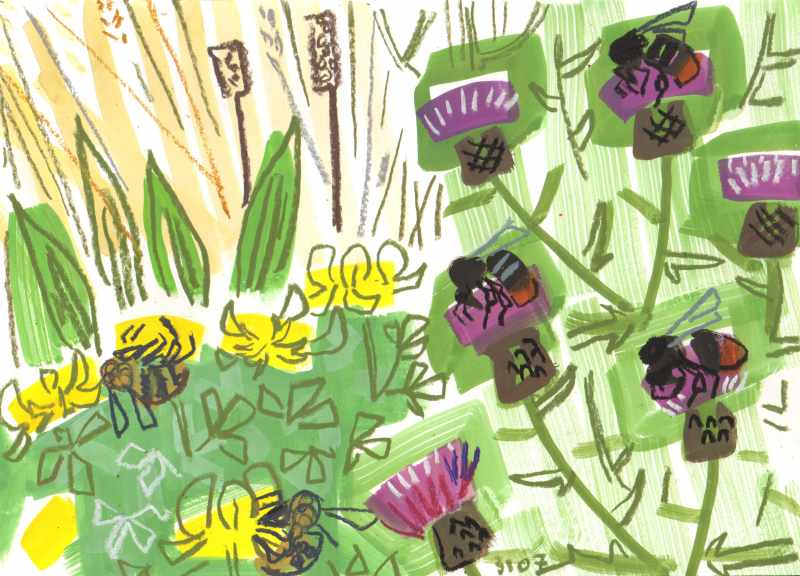
red-tailed bumbles on knapweed, carders on trefoil – allotment bristol – gouache & wax crayon – c. A3
Enjoying plugging away at how to interpret themes just outside the back door. The main study theme for the day was common blue butterflies… I’m really gratified when they stick around… there is now masses of birdsfoot trefoil to keep them happy and i’d like to up the numbers. I really get bogged down drawing them though… getting hung up on detail. Think it may take a while before they can sit alongside the bees in a sketch. The blue on the sketch below hopelessly wrong and remember getting caught out by them this time last year.
2 fairly distinct hoverfly spp. that I’ve yet to look up.
When I was having lunch a sparrowhawk made a lunge at the young great tits that have been creating a carousel effect on the bird table. Flashed in and then momentarily perched unstably on the washing line over my laundry. Sense of it seething/flaring and then off.
Focusing on knapweed. in the morning I returned to ink pen drawing… filling sheets to explore the details that I felt least sure of… mainly how to capture the bumblebees but there were new species of hoverfly that I hadn’t sketched & I wanted to look more in detail at the character of the knapweed. Easy to make generic patterns that miss new minute observed ‘truths’.



